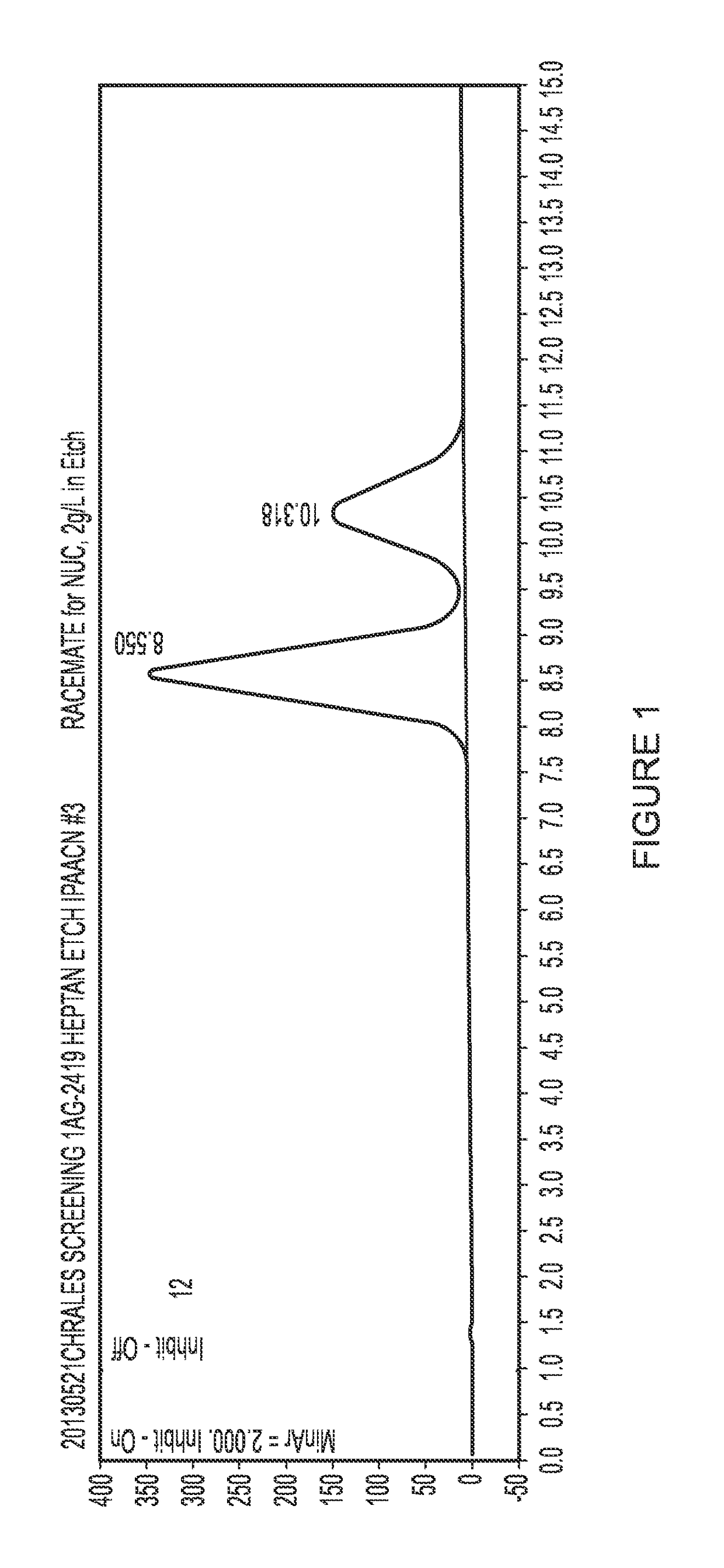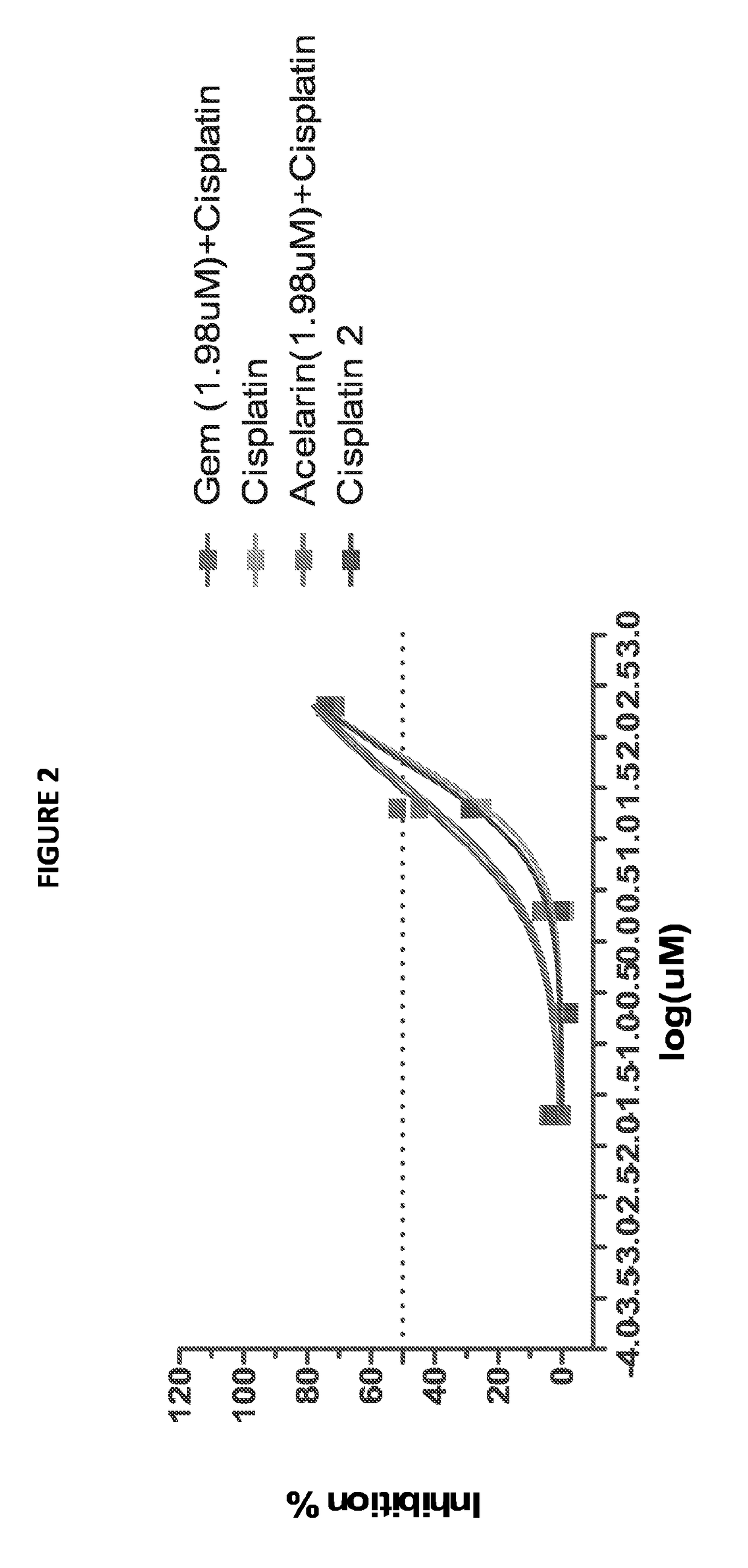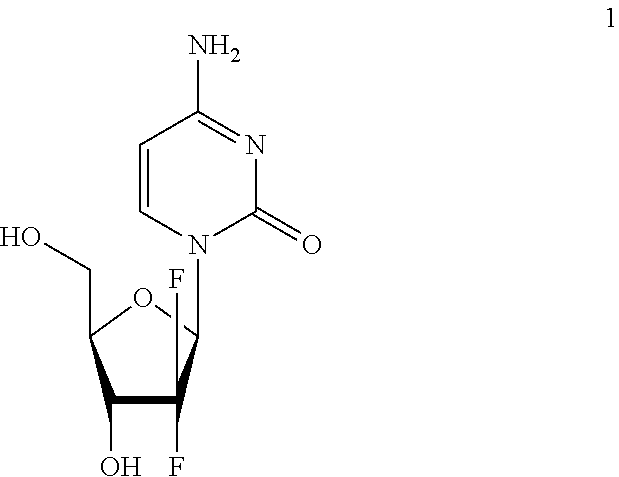Combination therapy
a combination therapy and therapy technology, applied in the field of combination therapy, can solve the problems of poor prognosis of patients diagnosed with advanced (metastatic or unresectable locally advanced disease) biliary tract cancer, limited clinical utility of gemcitabine, etc., and achieve the effect of improving the survival rate of patients
- Summary
- Abstract
- Description
- Claims
- Application Information
AI Technical Summary
Benefits of technology
Problems solved by technology
Method used
Image
Examples
example 1
astereoisomers of NUC-1031
[0170]The (R) and (S) isomers can be separated by HPLC under the following conditions:
Equipment: Agilent 1200™ series with DAD detector
Flow rate: 1.0 mL / min
Column: Chiralpak AD™; 250×4.6 mm ID (normal phase)
Temperature: ambient
Particle size: 20 μm
Feed: dissolved in MeOH; 10 g / L
Solvent: n-heptane / IPA 10->50% isopropyl alcohol
The chromatogram is shown in FIG. 1. The (S)-epimer eluted at 8.6 min and the (R)-epimer eluted at 10.3 minutes.
[0171]Characterisation Methods and Materials:
[0172]Proton (1H), carbon (13C), phosphorus (31P) and fluorine (19F) NMR spectra were recorded on a Bruker Avance 500 spectrometer at 25° C. Spectra were auto-calibrated to the deuterated solvent peak and all 13C NMR and 31P NMR were proton-decoupled. The purity of final compounds can be verified by HPLC analysis using Varian Polaris C18-A (10 μM) as an analytic column with a gradient elution of H2O / MeOH from 100 / 0 to 0 / 100 in 35 min. The HPLC analysis was conducted by Varian Prostar...
example 2
and Cisplatin Combination Study In Vitro
2.1 Materials and Methods
Cell Cultures and Reagents
[0185]A2780, SK-OV-3, OVCAR-3, NCI-H460, NCI-H1975, NCI-H2122, 5637 and HT1376 were cultured in RPMI Medium 1640 (Invitrogen-22400105) supplemented with 10% fetal bovine serum (FBS; Invitrogen-10099141). All the cell lines were maintained in a humidified incubator at 37° C. with 5% CO2. Cell culture media and supplements were purchased from Invitrogen, and tissue culture flasks were purchased from Corning, 96-well plates and 384-well plates were purchased from Greiner. CellTiter-Glo Luminescent Cell Viability Assay kits were purchased from Promega (Promega-G7573), cells counter Vi-Cell was purchased from Beckman, detection instrument Envision was purchased from PerkinElmer.
[0186]Paclitaxcel (used as a reference) and cisplatin were purchased from SELLECK, and they were of highest purity available. All compounds attained solubility in DMSO and when diluted into culture media. DMSO, compounds sol...
example 3
UC-1031 and Cisplatin Combination In Vitro Study
Cell Culture and Reagents
[0208]SKOV3 cells were purchased from American Type Culture Collection (ATCC). They were cultured at 37° C. and 5% CO2 in Gibco™ RMPI Medium 1640+GlutaMAX™-I (Life Technologies; 61870-010) with 10% Gibco™ FBS (Life Technologies; 10270-106) and 1% Gibco™ Penicillin-Streptomycin (Life Technologies; Ser. No. 15 / 140,122), known as complete medium, in a cell culture flask. Cisplatin was purchased from TEVA UK Limited (PL 00289 / 1146). Fluvastatin and Sulforaphane were both purchased from Merck Millipore Corporation (Catalogue numbers 344096 and 574215 respectively). (S)-NUC-1031 was provided by NuCana® Ltd.
Cell Culture with Drug Applications
[0209]SKOV3 cells were plated at 250 cells in 200 μl per well in in the middle 60 wells of Costar® 3596 96-well plates, with the outer 36 wells filled with 200 μl PBS each. The cells were allowed to grow in complete medium for 48 hours before different drug compounds were added in...
PUM
| Property | Measurement | Unit |
|---|---|---|
| Volume | aaaaa | aaaaa |
| Volume | aaaaa | aaaaa |
| Volume | aaaaa | aaaaa |
Abstract
Description
Claims
Application Information
 Login to View More
Login to View More - R&D
- Intellectual Property
- Life Sciences
- Materials
- Tech Scout
- Unparalleled Data Quality
- Higher Quality Content
- 60% Fewer Hallucinations
Browse by: Latest US Patents, China's latest patents, Technical Efficacy Thesaurus, Application Domain, Technology Topic, Popular Technical Reports.
© 2025 PatSnap. All rights reserved.Legal|Privacy policy|Modern Slavery Act Transparency Statement|Sitemap|About US| Contact US: help@patsnap.com



